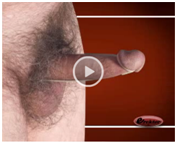CT-guided transgluteal prostate
biopsy
• The patient needs to fast for 6 h before the
procedure.
• Antibiotic prophylaxis is not routinely used.
• Intravenous conscious sedation is used with
midazolam and fentanyl. Oxygen saturation,
blood pressure, and heart rate and rhythm are
monitored throughout the procedure.
• The patient is placed prone on the CT table.
• Lidocaine infiltration of the skin and soft
tissues is performed. Peri-prostatic lidocaine
is not necessary in this scenario.
• Under CT guidance and using a transgluteal
approach, two 17-gauge coaxial systems
are advanced to the near surface of the
peripheral zone of the prostate on each side. The
17-gauge needle is manipulated to guide the
core caudally, cranially, medially and laterally
in the prostate and biopsies are taken at the
apex, midway between the apex and
base and at the base. Twelve 18-gauge cores are
obtained.
• A post-procedure CT is performed to rule out
any immediate complication.
Immediate Post-Procure Care
CT-guided Transgluteal Prostate Biopsy
• The patient may be discharged 3 h after the procedure,
if stable.
Complications
• Infections: Febrile urinary tract infection,
bacteremia or acute prostatitis. Rare cases of
fatal septicemia have been reported. Treatment
is achieved with oral or intravenous antibiotics depending on the severity of the
infection.
• Bleeding: Rectal bleeding, hematuria or
hematospermia. Usually bleeding is self-limiting
and should resolve within 1 week. More
significant rectal bleeding may require
anoscopic intervention.
• Acute urinary retention has been described, especially
in patients with significant BPH.
Alternative Procedures/Future
Directions
• Contrast-enhanced transrectal ultrasound:
Infusion of intravenous microbubble ultrasound
contrast agents can amplify flow signals within
the microvasculature of prostate
tumors, thus making them more conspicuous and
allowing for more accurate biopsy
sampling of the prostate.
Key pointsey Points
›› Antibiotic prophylaxis is needed for transrectal US-guided prostate biopsy.
›› Extended biopsy schemes should be performed
with five peripheral and one
central core on either side of the prostate,
with additional cores for any
hypoechoic lesions detected.
›› Transgluteal CT-guided prostate biopsy can be performed in patients
lacking a
rectum.
›› Most common complications include infections
and bleeding (rectal, hematuria,
hematospermia).
IInterventional Radiology Procedures in Biopsy
and Drainage,
DOI: 10.1007/978-1-84800-899-1_12, © Springer-Verlag London Limited 2011



